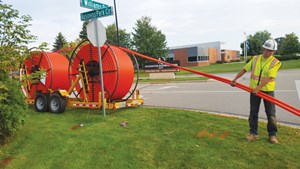March 2021 Vol. 76 No. 3
Features
Alliant Energy Conduit Loop Project Earns Project of the Year Award
Alliant Energy Corporation’s Grid Modernization Program is using high-density polyethylene (HDPE) conduit for the core fiber optic ring that runs 600 miles in the northeast corner of Iowa and into the southwest corner of Wisconsin. The ring is under construction and is scheduled to be completed during the first half of 2021.
In May 2020, the ongoing effort was named Project of the Year by the Power and Communications Division of the Plastics Pipe Institute, Inc. (PPI), a North American association representing the plastic pipe industry. PPI member company, Teel Plastics, LLC, (Baraboo, Wisc.), manufacturer of the conduit, received the honor during the association’s annual meeting, which was held virtually.
The association’s annual awards program recognizes projects and members for exceptional contributions to the industry. Submissions in the association’s divisions are reviewed, evaluated and voted upon by the PPI members.
“Fiber optic cable is the preferred network backbone because the grid of the future will be far more data intensive,” explained David Fink, president of PPI when he presented the award to Teel’s Christian Herrild. “Sensors, smart meters, fault interrupters and other digital devices are transforming how customers receive, use and generate energy. This means massive amounts of information will need to flow back and forth smoothly, securely and continuously,”
Conduit manufactured by Teel Plastics is supporting Alliant Energy’s plans to strengthen its communications system by installing a fiber optic network to enable continuous flow of information from its electric distribution system. The project will leverage new technologies, tools, data and practices to provide customer and company benefits. It will also decrease reliance on over-the-air communication, such as microwave radios.
Alliant Energy provides electric service to 970,000 customers across Wisconsin and Iowa. The company’s service area boundaries cover more than 54,000 miles, making communications reliability and capacity vital. The 1 ¼-inch diameter, SDR 11 HDPE conduit is designed to protect the existing infrastructure and allow for later expansion of network capabilities for the Midwest utility.
“The project will create a fiber ring,” explained Ed Gilkes, Alliant Energy project manager, “connecting our corporate headquarters in Madison to our general office in Cedar Rapids. Along the route, we’ll connect as many facilities as possible. This will increase data transmission speed, plus give us more control and security of the fiber optic service.”
“HDPE conduit is the material of choice for protecting fiber optic networks from the environment and pests,” stated Patrick Vibien, P, Eng., director of engineering for PPI’s Power and Communications Division. “Its long service life, coupled with ease of installation, is unparalleled. HDPE conduit can be installed in long continuous lengths by horizontal directional drilling, vibratory plough, and open trench when needed.
“The ability to install in long lengths saves time and money by minimizing the impact to surrounding areas and limiting the labor needed. In addition, it provides a smooth, continuous pathway for blowing fiber long distances to reduce costs during the installation and splicing of the network it supports.”
Vibien also pointed to HDPE conduit benefits for fiber optic networks demonstrated by this project. “It makes large-scale private network projects like this one viable for customers where network reliability is critical and the requirements for bandwidth are ever increasing. Similar successes have shown that private network projects built with an eye to the future using HDPE conduit area a good investment.” •
FOR MORE INFORMATION:
Plastics Pipe Institute, plasticpipe.org





Comments